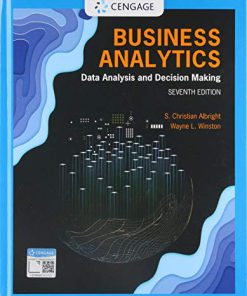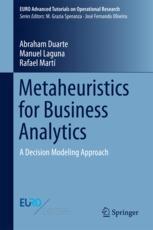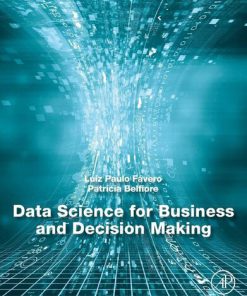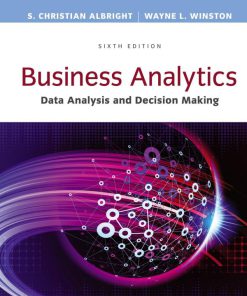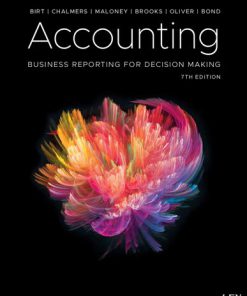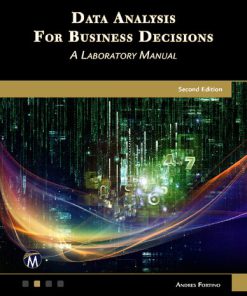Business Analytics for Decision Making 1st Edition by Kimbrough,Hoong Chuin Lau 1482221764 9781482221763
$50.00 Original price was: $50.00.$25.00Current price is: $25.00.
Business Analytics for Decision Making 1st Edition by Kimbrough,Hoong Chuin Lau – Ebook PDF Instant Download/Delivery:1482221764,9781482221763
Full download Business Analytics for Decision Making 1st Edition after payment
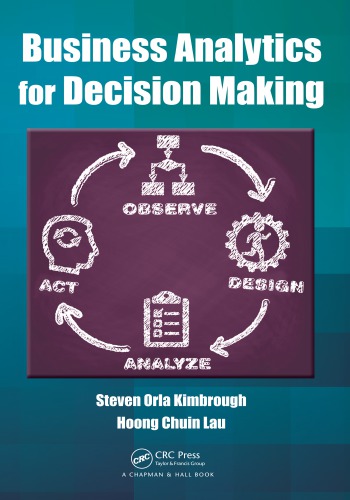
Product details:
ISBN 10:1482221764
ISBN 13:9781482221763
Author: Kimbrough,Hoong Chuin Lau
Business Analytics for Decision Making, the first complete text suitable for use in introductory Business Analytics courses, establishes a national syllabus for an emerging first course at an MBA or upper undergraduate level. This timely text is mainly about model analytics, particularly analytics for constrained optimization. It uses implementations that allow students to explore models and data for the sake of discovery, understanding, and decision making.
Business analytics is about using data and models to solve various kinds of decision problems. There are three aspects for those who want to make the most of their analytics: encoding, solution design, and post-solution analysis. This textbook addresses all three. Emphasizing the use of constrained optimization models for decision making, the book concentrates on post-solution analysis of models.
The text focuses on computationally challenging problems that commonly arise in business environments. Unique among business analytics texts, it emphasizes using heuristics for solving difficult optimization problems important in business practice by making best use of methods from Computer Science and Operations Research. Furthermore, case studies and examples illustrate the real-world applications of these methods.
The authors supply examples in Excel®, GAMS, MATLAB®, and OPL. The metaheuristics code is also made available at the book’s website in a documented library of Python modules, along with data and material for homework exercises. From the beginning, the authors emphasize analytics and de-emphasize representation and encoding so students will have plenty to sink their teeth into regardless of their computer programming experience.
Business Analytics for Decision Making 1st Table of contents:
I Starters
1 Introduction
1.1 The Computational Problem Solving Cycle
1.2 Example: Simple Knapsack Models
1.3 An Example: The Eilon Simple Knapsack Model
1.4 Scoping Out Post-Solution Analysis
1.4.1 Sensitivity
1.4.2 Policy
1.4.3 Outcome Reach
1.4.4 Opportunity
1.4.5 Robustness
1.4.6 Explanation
1.4.7 Resilience
1.5 Parameter Sweeping: A Method for Post-Solution Analysis
1.6 Decision Sweeping
1.7 Summary of Vocabulary and Main Points
1.8 For Exploration
1.9 For More Information
2 Constrained Optimization Models: Introduction and Concepts
2.1 Constrained Optimization
2.2 Classification of Models
2.2.1 (1) Linear Program (LP)
2.2.2 (2) Integer Linear Program (ILP)
2.2.3 (3) Mixed Integer Linear Program (MILP)
2.2.4 (4) Nonlinear Program (NLP)
2.2.5 (5) Nonlinear Integer Program (NLIP)
2.2.6 (6) Mixed Integer Nonlinear Program (MINLP)
2.3 Solution Concepts
2.4 Computational Complexity and Solution Methods
2.5 Metaheuristics
2.5.1 Greedy Hill Climbing
2.5.2 Local Search Metaheuristics: Simulated Annealing
2.5.3 Population Based Metaheuristics: Evolutionary Algorithms
2.6 Discussion
2.7 For Exploration
2.8 For More Information
3 Linear Programming
3.1 Introduction
3.2 Wagner Diet Problem
3.3 Solving an LP
3.4 Post-Solution Analysis of LPs
3.5 More than One at a Time: The 100 Rule
3.6 For Exploration
3.7 For More Information
II Optimization Modeling
4 Simple Knapsack Problems
4.1 Introduction
4.2 Solving a Simple Knapsack in Excel
4.3 The Bang-for-Buck Heuristic
4.4 Post-Solution Analytics with the Simple Knapsack
4.4.1 Sensitivity Analysis
4.4.2 Candle Lighting Analysis
4.5 Creating Simple Knapsack Test Models
4.6 Discussion
4.7 For Exploration
4.8 For More Information
5 Assignment Problems
5.1 Introduction
5.2 The Generalized Assignment Problem
5.3 Case Example: GAP 1-c5-15-1
5.4 Using Decisions from Evolutionary Computation
5.5 Discussion
5.6 For Exploration
5.7 For More Information
6 The Traveling Salesman Problem
6.1 Introduction
6.2 Problem Definition
6.3 Solution Approaches
6.3.1 Exact Algorithms
6.3.2 Heuristic Algorithms
6.3.2.1 Construction Heuristics
6.3.2.2 Iterative Improvement or Local Search
6.3.3 Putting Everything Together
6.4 Discussion
6.5 For Exploration
6.6 For More Information
7 Vehicle Routing Problems
7.1 Introduction
7.2 Problem Definition
7.3 Solution Approaches
7.3.1 Exact Algorithms
7.3.2 Heuristic Algorithms
7.3.2.1 Construction Heuristics
7.3.2.2 Iterative Improvement or Local Search
7.4 Extensions of VRP
7.5 For Exploration
7.6 For More Information
8 Resource-Constrained Scheduling
8.1 Introduction
8.2 Formal Definition
8.3 Solution Approaches
8.3.1 Exact Algorithms
8.3.2 Heuristic Algorithms
8.3.2.1 Serial Method
8.3.2.2 Parallel Method
8.3.2.3 Iterative Improvement or Local Search
8.4 Extensions of RCPSP
8.5 For Exploration
8.6 For More Information
9 Location Analysis
9.1 Introduction
9.2 Locating One Service Center
9.2.1 Minimizing Total Distance
9.2.2 Weighting by Population
9.3 A Naïve Greedy Heuristic for Locating n Centers
9.4 Using a Greedy Hill Climbing Heuristic
9.5 Discussion
9.6 For Exploration
9.7 For More Information
10 Two-Sided Matching
10.1 Quick Introduction: Two-Sided Matching Problems
10.2 Narrative Description of Two-Sided Matching Problems
10.3 Representing the Problem
10.4 Stable Matches and the Deferred Acceptance Algorithm
10.5 Once More, in More Depth
10.6 Generalization: Matching in Centralized Markets
10.7 Discussion: Complications
10.8 For More Information
III Metaheuristic Solution Methods
11 Local Search Metaheuristics
11.1 Introduction
11.2 Greedy Hill Climbing
11.2.1 Implementation in Python
11.2.2 Experimenting with the Greedy Hill Climbing Implementation
11.3 Simulated Annealing
11.4 Running the Simulated Annealer Code
11.5 Threshold Accepting Algorithms
11.6 Tabu Search
11.7 For Exploration
11.8 For More Information
12 Evolutionary Algorithms
12.1 Introduction
12.2 EPs: Evolutionary Programs
12.2.1 The EP Procedure
12.2.2 Applying the EP Code to the Test Problems
12.2.3 EP Discussion
12.3 The Basic Genetic Algorithm (GA)
12.3.1 The GA Procedure
12.3.2 Applying the Basic GA Code to a Test Problem
12.3.3 GA Discussion
12.4 For Exploration
12.5 For More Information
13 Identifying and Collecting Decisions of Interest
13.1 Kinds of Decisions of Interest (DoIs)
13.2 The FI2-Pop GA
13.3 Discussion
13.4 For Exploration
13.5 For More Information
IV Post-Solution Analysis of Optimization Models
14 Decision Sweeping
14.1 Introduction
14.2 Decision Sweeping with the GAP 1-c5-15-1 Model
14.3 Deliberating with the Results of a Decision Sweep
14.4 Discussion
14.5 For Exploration
14.6 For More Information
15 Parameter Sweeping
15.1 Introduction: Reminders on Solution Pluralism and Parameter Sweeping
15.2 Parameter Sweeping: Post-Solution Analysis by Model Re-Solution
15.2.1 One Parameter at a Time
15.2.2 Two Parameters at a Time
15.2.3 N Parameters at a Time
15.2.4 Sampling
15.2.5 Active Nonlinear Tests
15.3 Parameter Sweeping with Decision Sweeping
15.4 Discussion
15.5 For Exploration
15.6 For More Information
16 Multiattribute Utility Modeling
16.1 Introduction
16.2 Single Attribute Utility Modeling
16.2.1 The Basic Framework
16.2.2 Example: Bringing Wine
16.3 Multiattribute Utility Models
16.3.1. Multiattribute Example: Picking a Restaurant
16.3.2. The SMARTER Model Building Methodology
16.3.2.1 Step 1: Purpose and Decision Makers
16.3.2.2 Step 2: Value Tree
16.3.2.3 Step 3: Objects of Evaluation
16.3.2.4 Step 4: Objects-by-Attributes Table
16.3.2.5 Step 5: Dominated Options
16.3.2.6 Step 6: Single-Dimension Utilities
16.3.2.7 Step 7: Do Part I of Swing Weighting
16.3.2.8 Step 8: Obtain the Rank Weights
16.3.2.9 Step 9: Calculate the Choice Utilities and Decide
16.4 Discussion
16.5 For Exploration
16.6 For More Information
17 Data Envelopment Analysis
17.1 Introduction
17.2 Implementation
17.3 Demonstration of DEA Concept
17.4 Discussion
17.5 For Exploration
17.6 For More Information
18 Redistricting: A Case Study in Zone Design
18.1 Introduction
18.2 The Basic Redistricting Formulation
18.3 Representing and Formulating the Problem
18.4 Initial Forays for Discovering Good Districting Plans
18.5 Solving a Related Solution Pluralism Problem
18.6 Discussion
18.7 For Exploration
18.8 For More Information
V Conclusion
19 Conclusion
19.1 Looking Back
19.2 Revisiting Post-Solution Analysis
19.3 Looking Forward
19.3.1 Uncertainty
19.3.2 Argumentation
A Resources
A.1 Resources on the Web
People also search for Business Analytics for Decision Making 1st:
business analytics for decision making notes
business analytics for decision making coursera quiz answers
business analytics for decision making notes pdf
business intelligence and analytics systems for decision support
analytics for business decision making george brown
Tags:
Kimbrough,Hoong Chuin Lau,Decision,Business,Analytics
You may also like…
Business & Economics - Economics
Business Analytics: Data Analysis & Decision Making (MindTap Course List) 7th Edition Albright
Business & Economics - Others
Business & Economics - Accounting
Accounting: Business Reporting for Decision Making (Sixth Edition) Jacqueline Birt
Computers - Applications & Software
Business & Economics - Responsibility and Business Ethics
Business & Economics - Mathematical Economics
Data Science for Business and Decision Making 1st Edition Luiz Paulo Fávero
Business & Economics
Accounting: Business Reporting for Decision Making (Seventh Edition) Jacqueline Birt
Mathematics
Data Analysis for Business Decision Making: A Laboratory manual 2nd Edition Andres Fortino




